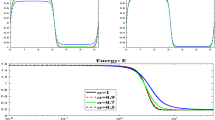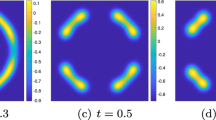Abstract
We build an asymptotically compatible energy of the variable-step L2-\(1_{\sigma }\) scheme for the time-fractional Allen–Cahn model with the Caputo’s fractional derivative of order \(\alpha \in (0,1)\), under a weak step-ratio constraint \(\tau _k/\tau _{k-1}\ge r_{\star }(\alpha )\) for \(k\ge 2\), where \(\tau _k\) is the k-th time-step size and \(r_{\star }(\alpha )\in (0.3865,0.4037)\) for \(\alpha \in (0,1)\). It provides a positive answer to the open problem in Liao et al. (J Comput Phys 414:109473, 2020), and, to the best of our knowledge, it is the first second-order nonuniform time-step** scheme to preserve both the maximum bound principle and the energy dissipation law of time-fractional Allen–Cahn model. The compatible discrete energy is constructed via a novel discrete gradient structure of the second-order L2-\(1_{\sigma }\) formula by a local-nonlocal splitting technique. It splits the discrete fractional derivative into two parts: one is a local term analogue to the trapezoid rule of the first derivative and the other is a nonlocal summation analogue to the L1 formula of Caputo derivative. Numerical examples with an adaptive time-step** strategy are provided to show the effectiveness of our scheme and the asymptotic properties of the associated modified energy.






Similar content being viewed by others
Data Availibility
All data generated or analysed during this study are included in this published article.
References
Alikhanov, A.A.: A new difference scheme for the time fractional diffusion equation. J. Comput. Phys. 280, 424–438 (2015)
Allen, S., Cahn, J.: A microscopic theory for antiphase boundary motion and its application to antiphase domain coarsening. Acta Metall. 27, 1085–1095 (1979)
Du, Q., Yang, J., Zhou, Z.: Time-fractional Allen–Cahn equations: analysis and numerical methods. J. Sci. Comput. 85, 11 (2020)
Feng, X., Prohl, A.: Numerical analysis of the Allen–Cahn equation and approximation for mean curvature flows. Numer. Math. 94, 33–65 (2003)
Hou, D., Xu, C.: Highly efficient and energy dissipative schemes for time fractional Allen–Cahn equation. SIAM J. Sci. Comput. 43(5), A3305–A3327 (2021)
Hou, D., Zhu, H., Xu, C.: Highly efficient schemes for time-fractional Allen–Cahn equation using extended SAV approach. Numer. Algorithms 88, 1077–1108 (2021)
Hou, D., Xu, C.: A second order energy dissipative scheme for time fractional \(L^2\) gradient flows using SAV approach. J. Sci. Comput. 90(1), 1–22 (2022)
Hou, T., Tang, T., Yang, J.: Numerical analysis of fully discretized Crank–Nicolson scheme for fractional-in-space Allen–Cahn equations. J. Sci. Comput. 72(3), 1214–1231 (2017)
Huang, J., Yang, C., Wei, Y.: Parallel energy-stable solver for a coupled Allen–Cahn and Cahn–Hilliard system. SIAM J. Sci. Comput. 42, C294–C312 (2020)
Ji, B., Liao, H.-L., Zhang, L.: Simple maximum-principle preserving time-step** methods for time-fractional Allen–Cahn equation. Adv. Comput. Math. 46, 37 (2020)
Ji, B., Liao, H.-L., Gong, Y., Zhang, L.: Adaptive second-order Crank–Nicolson time-step** schemes for time fractional molecular beam epitaxial growth models. SIAM J. Sci. Comput. 42, B738–B760 (2020)
Ji, B., Zhu, X., Liao, H.-L.: Energy stability of variable-step L1-type schemes for time-fractional Cahn–Hilliard model. Commun. Math. Sci 21(7), 1767–1789 (2023)
Jiang, S., Zhang, J., Qian, Z., Zhang, Z.: Fast evaluation of the Caputo fractional derivative and its applications to fractional diffusion equations. Commun. Comput. Phys. 21, 650–678 (2017)
Karaa, S.: Positivity of discrete time-fractional operators with applications to phase-field equations. SIAM J. Numer. Anal. 59, 2040–2053 (2021)
Kopteva, N.: Error analysis for time-fractional semilinear parabolic equations using upper and lower solutions. SIAM J. Numer. Anal. 58, 2212–2234 (2020)
Kopteva, N., Meng, X.: Error analysis for a fractional-derivative parabolic problem on quasi-graded meshes using barrier functions. SIAM J. Numer. Anal. 58, 1217–1238 (2020)
Li, Z., Wang, H., Yang, D.: A space-time fractional phase-field model with tunable sharpness and decay behavior and its efficient numerical simulation. J. Comput. Phys. 347, 20–38 (2017)
Liao, H.-L., Liu, N., Zhao, X.: Asymptotically compatible energy of variable-step fractional BDF2 formula for time-fractional Cahn–Hilliard model. ar**v: 2210.12514v1 (2022)
Liao, H.-L., McLean, W., Zhang, J.: A discrete Grönwall inequality with application to numerical schemes for subdiffusion problems. SIAM J. Numer. Anal. 57, 218–237 (2019)
Liao, H.-L., McLean, W., Zhang, J.: A second-order scheme with nonuniform time steps for a linear reaction-subdiffusion problem. Commun. Comput. Phys. 30(2), 567–601 (2021)
Liao, H.-L., Tang, T., Zhou, T.: A second-order and nonuniform time-step** maximum-principle preserving scheme for time-fractional Allen–Cahn equations. J. Comput. Phys. 414, 109473 (2020)
Liao, H.-L., Tang, T., Zhou, T.: An energy stable and maximum bound preserving scheme with variable time steps for time fractional Allen–Cahn equation. SIAM J. Sci. Comput. 43(5), A3503–A3526 (2021)
Liao, H.-L., Zhu, X., Wang, J.: An adaptive L1 time-step** scheme preserving a compatible energy law for the time-fractional Allen–Cahn equation. Numer. Math. Theor. Methods Appl. 15(4), 1128–1146 (2022)
Liu, H., Cheng, A., Wang, H., Zhao, J.: Time-fractional Allen–Cahn and Cahn–Hilliard phase-field models and their numerical investigation. Comput. Math. Appl. 76, 1876–1892 (2018)
Quan, C., Tang, T., Wang, B., Yang, J.: A decreasing upper bound of energy for time-fractional phase-field equations. Commun. Comput. Phys. 33, 962–991 (2023)
Quan, C., Tang, T., Yang, J.: How to define dissipation-preserving energy for time-fractional phase-field equations. CSIAM Trans. Appl. Math. 1, 478–490 (2020)
Quan, C., Wu, X.: Global-in-time \(H^1\)-stability convergence of L2–1\(_\sigma \) method on general nonuniform meshes for subdiffusion equation. J. Sci. Comput. 95, 59 (2023)
Quan, C., Wu, X.: \(H^1\)-norm stability and convergence of an L2-type method on nonuniform meshes for subdiffusion equation. SIAM J. Numer. Anal. 61(5), 2106–2132 (2023)
Tang, T., Yu, H., Zhou, T.: On energy dissipation theory and numerical stability for time-fractional phase field equations. SIAM J. Sci. Comput. 41, A3757–A3778 (2019)
Zhang, Z., Qiao, Z.: An adaptive time-step** strategy for the Cahn–Hilliard equation. Commun. Comput. Phys. 11, 1261–1278 (2012)
Zhao, J., Chen, L., Wang, H.: On power law scaling dynamics for time-fractional phase field models during coarsening. Commun. Nonlinear Sci. 70, 257–270 (2019)
Funding
This work is supported by NSF of China under Grant Number 12071216.
Author information
Authors and Affiliations
Corresponding author
Ethics declarations
Conflict of interest
The authors declare that they have no Conflict of interest.
Human or Animal Rights
This article does not contain any studies involving animals performed by any of the authors.
Additional information
Publisher's Note
Springer Nature remains neutral with regard to jurisdictional claims in published maps and institutional affiliations.
Rights and permissions
Springer Nature or its licensor (e.g. a society or other partner) holds exclusive rights to this article under a publishing agreement with the author(s) or other rightsholder(s); author self-archiving of the accepted manuscript version of this article is solely governed by the terms of such publishing agreement and applicable law.
About this article
Cite this article
Liao, Hl., Zhu, X. & Sun, H. Asymptotically Compatible Energy and Dissipation Law of the Nonuniform L2-\(1_{\sigma }\) Scheme for Time Fractional Allen–Cahn Model. J Sci Comput 99, 46 (2024). https://doi.org/10.1007/s10915-024-02515-3
Received:
Revised:
Accepted:
Published:
DOI: https://doi.org/10.1007/s10915-024-02515-3
Keywords
- Time-fractional Allen–Cahn model
- Discrete gradient structure
- Discrete energy dissipation law
- Maximum bound principle
- Asymptotic compatibility




